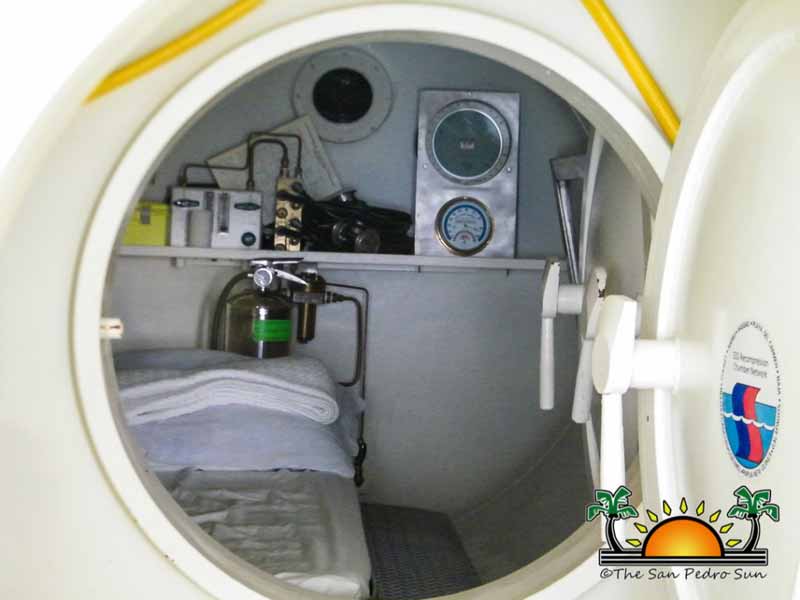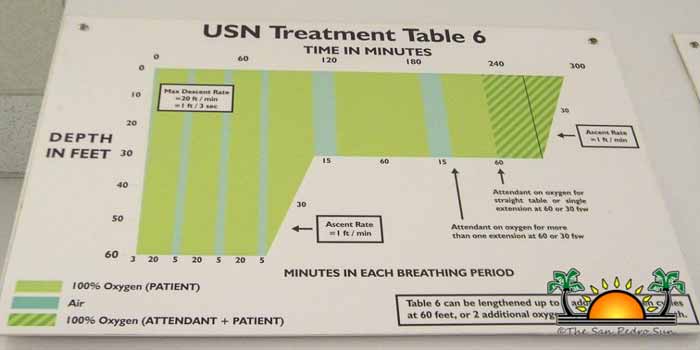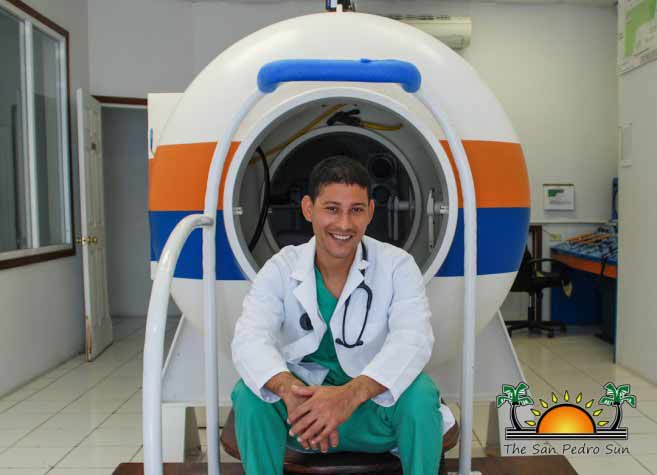Hyperbaric Chambers on Ambergris CayeThere are now two hyperbaric chambers operational in Belize. Both chambers are double lock hyperbaric chambers and are found in San Pedro Town. San Pedro is proud of its safe diving record and equally proud of its chambers. You can dive with peace of mind and enjoy the hundreds of dive sites found in Belize. Emergency service is available 24 hours, every day at both chambers.
Brief History Of Chambers In BelizeSubaquatic Safety of Belize Ltd. opened its doors to the diving community of Belize in 1989, by now serving the community for over 25 years. At that time and for many years following, the Subaquatic Safety of Belize Ltd. was the only chamber in Belize. It started its operations with about 8 dive shops. In early 2002 a new clinic facility was built (The photo of building front to the right was the original one, it looks different now.). To learn more about this chamber visit: http://www.sssnetwork.com/our-chambers-and-medical-clinics/belize-central-america/ 
The Belize Chamber Project LTD opened its doors in May 2015 making it the second chamber in Belize to address the needs of the diving community. The Belize Chamber Project started its operation with the full support of all the dive operators and conservation organizations in Belize. They are the only hyperbaric facility in Belize that is a DAN Preferred Provider. To learn more about this chamber visit: http://belizechamber.com/  POINTERS FOR TROUBLE-FREE DIVING Taking preventive precautions will greatly reduce your chance of experiencing bad side effects after diving. This does not guarantee however, that you are 100% RISK-FREE. Most often an aggregate of mild symptoms marks the beginning of Decompression Sickness (DCS). Never neglect to accept this; do not treat with frivolity. If detected early the outcome chance of being speedy and 100% satisfactory recovery dramatically increases. DO: Drink plenty of water (prevent dehydration) and dive conservatively within table/computer limits; ascend slowly- no faster than 30 fpm. Take appropriate surface intervals after every dive. Plan your dives and dive your plan. Take First Aid courses and an Emergency Oxygen course to know what to do in an emergency situation. DON'T: Over-exercise; take hot showers or baths after diving; drink alcohol, coffee and sodas immediately before/or after; avoid getting too cold during and after diving; avoid greasy foods; do not fly immediately after a dive.
(A) Contact local Emergency Services ASAP. (B) Check airway, breathing, and circulation - (ABCs) (C) Administer 100% oxygen (D) Place diver in recovery position (E) Call DAN Emergency Hotline to receive further medical information from experienced dive medics DAN EMERGENCY CONTACT NUMBERS DAN 24 Hr. Emergency +1-919-684-9111 DAN Member services +1-919-684-2948 Website: http://www.diversalertnetwork.org/ Call DAN to receive non-emergency medical information and location of hyperbaric chambers nearby. DIVE INSURANCE Consider purchasing dive insurance because the expense adds up quickly when a situation does occur. Some shops won’t even take you out if you do not have dive insurance. Be sure to shop around and buy the insurance plan that fits your diving needs. WHAT ARE DCS AND AGE Decompression sickness (DCS), which may occur in divers after decompression from a dive, is dependent on the combined dose of gas saturation during the dive and the rate and magnitude of decompression. However, there is a great variability of outcomes in subjects exposed to the same dive profiles. The variability decreases as the severity of exposure increases. https://thedivelab.wordpress.com/category/decompression-sickness-2/ https://thedivelab.wordpress.com/2015/07/10/can-a-test-identify-divers-who-may-be-more-susceptible-to-dcs/#more-642
Cutaneous decompression sickness (DCS), or “skin bends,” most often manifests as skin mottling on the torso, upper arms and buttocks to various degrees. An associated marbled look to the skin is sometimes referred to as cutis marmorata. While cutaneous DCS is most likely related to gas occurring in body — after decompression or due to lung barotrauma or some medical procedures — there generally is no accepted explanation how the free gas is related to skin changes. https://thedivelab.wordpress.com/category/arterial-gas-embolism/ CONCLUSION Diving is a relatively safe sport, however, there will always be potential emergencies. Whether these emergencies evolve into a full-blown accident or death often depends on the immediate care the victim receives. All divers should be aware of the causes, signs, and symptoms of potential diving emergencies and be prepared—taking courses to learn what to do in emergency situations makes a difference and could save lives. Ensuring dive buddies are properly trained in emergencies is just as important; the victim may not always be someone else, it could be you! DAN EMERGENCY CONTACT NUMBERS DAN 24 Hr. Emergency 001-919-684-8111 DAN Travel Assist: 001-202-296-9620 DAN Member services 001-919-684-2948 Ext. 333 Below here are articles from the paper over the years on the hyperbaric chambers. San Pedro’s Hyperbaric Chamber opens its service to all dive guidesSince 1989 Sub-Aquatic Safety Service (SSS) Network has been operating the only recompression chamber for divers in Belize. The recompression chamber that is owned by Sub-aquatic Safety of Belize Limited is essential to the diving industry since it provides all the necessary resources to treat diving accidents. The purpose of the chamber is to allow divers to readjust to normal atmospheric pressure after resurfacing from a dive. When divers surface from great depths too quick their body does not have time to readjust to normal atmospheric pressure and this can cause various pressure-related complications, such as oxygen toxicity and decompression sickness.  In a meeting with tour operators on Tuesday May 28th, it was revealed that services of the recompression chamber will now be offered to all dive operators of San Pedro Town in the case of a dive accident, regardless of their insurance coverage. The service is being given to all tour operators working with a dive shop associated with SSS Network. In order to access this service the tour operators must register with SSS Network; upon registration they will receive a member card that will identify the diver as eligible to receive full services of the recompression chamber and treatment.  According to Paul Moreno, Regional Supervisor of the SSS Recompression Chamber, the purpose of this proposal is to ensure the safety of Belize’s dive operators. “We are offering the tour guides operating out of San Pedro and eventually Belize the added benefit to be covered by our chamber facility in case of an accident, regardless of their primary or secondary insurance. So the added benefit is that any diver, out with an affiliated operator who ended up getting sick in the water can come to us and receive a full treatment, free of charge,” stated Moreno in an interview with The San Pedro Sun. SSS Network provides its service mostly to professional divers that come to Belize to participate in sports diving. Previously SSS Network encouraged divers to have an insurance policy that covered decompression treatment. This insurance can be rather costly here in Belize, so many of our local divers were not eligible to receive this coverage. “In the past, we encouraged dive shops to push their divers to have the added insurance. We now understand that it might have been an unnecessary burden on the dive guides, especially given the fact that they do most of their dives here in Ambergris Caye. Because we are the only providers here in Belize, it is an extra service and so we will take care of the divers,” said Moreno. This new bond that is being formed between the recompression chamber and dive guides is extremely important to strengthen diving in Belize. “The divers need to have the security that if anything happens while in the water, the first priority for the guides is to take care of their clients. Guides have some risk they need to have the peace of mind that if they get sick there is a recompression facility here that will treat them,” stated Moreno. As part of the outreach and education campaign, the chamber will also be providing courses and seminars to educate dive guides on diving medicine. The skills taught will be beneficial in strengthening the diving community. To obtain further information on the chamber or to register, visit the SSS Recompression Chamber located in font of Maya Island Air or call 226-2851/226-3195.  Second Hyperbaric Chamber Installed in San Pedro as Private Clinic Expands ServicesAmbergris Hopes Clinic, in San Pedro, Ambergris Caye, Belize, this week boasts the services of hyperbaric medicine treatment as it inaugurated a new building in its compound that houses the island’s second Hyperbaric Chamber. Official inauguration was held on Friday, May 15, 2015. In its first phase of expanding services and facilities, Ambergris Hopes Clinic sees the addition of hyperbaric medicine which will not only provide more sense of safety in the tourism sector but also provide additional treatment to various other conditions that can benefit from hyperbaric medicine. Working along with Dr. Gonzalez is Dr. Miguel Allison Del Valle who stressed that while the primary use of the chamber is for diving-related incidents, it can be used for treating other medical conditions dealing with diabetes, ulcers and brain issues such as strokes. Both doctors stress the importance for such a piece of equipment on an island that strongly depends on tourism. “The hyperbaric chamber assures a sense of security and safety to all who visit our island,” commented Dr. Daniel. “We will be visiting dive shops and resorts to educate them about the service we provide with the chamber so that they know about the reliable and essential services we have to offer with its addition to the clinic.” Dr. Daniel Gonzalez, who owns Ambergris Hopes Clinic, is working on providing a 24-hour medical facility, the first private clinic on the island to do so. Once complete the clinic will also be providing additional medical services from maternity to dentistry and also offer X-Ray and ultrasound. The expansion will allow for more doctor offices, recovery rooms and an operating room as well. Attending the inauguration event was local businessman Corry McDermott who made a donation of $5,000 towards the second phase of the clinic expansion which includes a diagnostic center with X-Ray and ultrasound, and a maternity ward. Dr. Danny, as he is affectionately called by islanders, has big dreams for his clinic and his goal is to provide excellent medical services to the community at affordable prices. His hopes is to also acquire an ambulance to assist in medical emergencies.
Belize’s Hyperbaric Chamber introduces resident general practitioner and dive medic The Sub-aquatics of Belize Limited is pleased to present new general practitioner and certified dive medic, Dr. Cornelio Teck. Originally from San Ignacio Town, Cayo District, Dr. Teck received his medical education in Cuba, after which he did his internship program in both Belmopan and Belize City. He has recently moved to Ambergris Caye, where he now offers his many services in San Pedro Town at the Hyperbaric Chamber. Dr. Teck has been trained and is a certified chamber tender and operator. He has treated diving accidents in Playa Del Carmen and Cozumel, Mexico from initial urgent care, assessment, to neurological examinations, diagnosis, treatment and prescriptions. However, his services go beyond hyperbaric medicine, offering family medicine with knowledge in pathologies pertaining to general surgery, orthopedics, pediatrics and internal medicine. As an added bonus, Dr. Teck is also offering free consultations for Dive Masters. He is eager to work alongside other doctors in the community, especially certified dive medics, as he grows into his role at the Hyperbaric Chamber. He will be residing in the same building as well. The chamber also announces that tours will be offered every Wednesday, starting March 1st. Visitors are invited to tour the facility, look at the chamber unit itself and learn how it is set up, and what equipment is being used to ensure that our community, in particular the dive community, remains safe. There will be a 10 AM and a 5 PM guided tour. The Sub-aquatics of Belize Limited has been offering hyperbaric medical treatment to the country’s visiting and local dive community for over 25 years. They are located right across the San Pedro Airstrip opposite Maya Island Air. You can contact them at telephone number (501) 226-2851, 615-4288 or email them at [email protected].
Diving off Ambergris Caye and the Belize Barrier Reef Ambergris Caye Visitors Center
 Copyright by Advantage Information Management |


